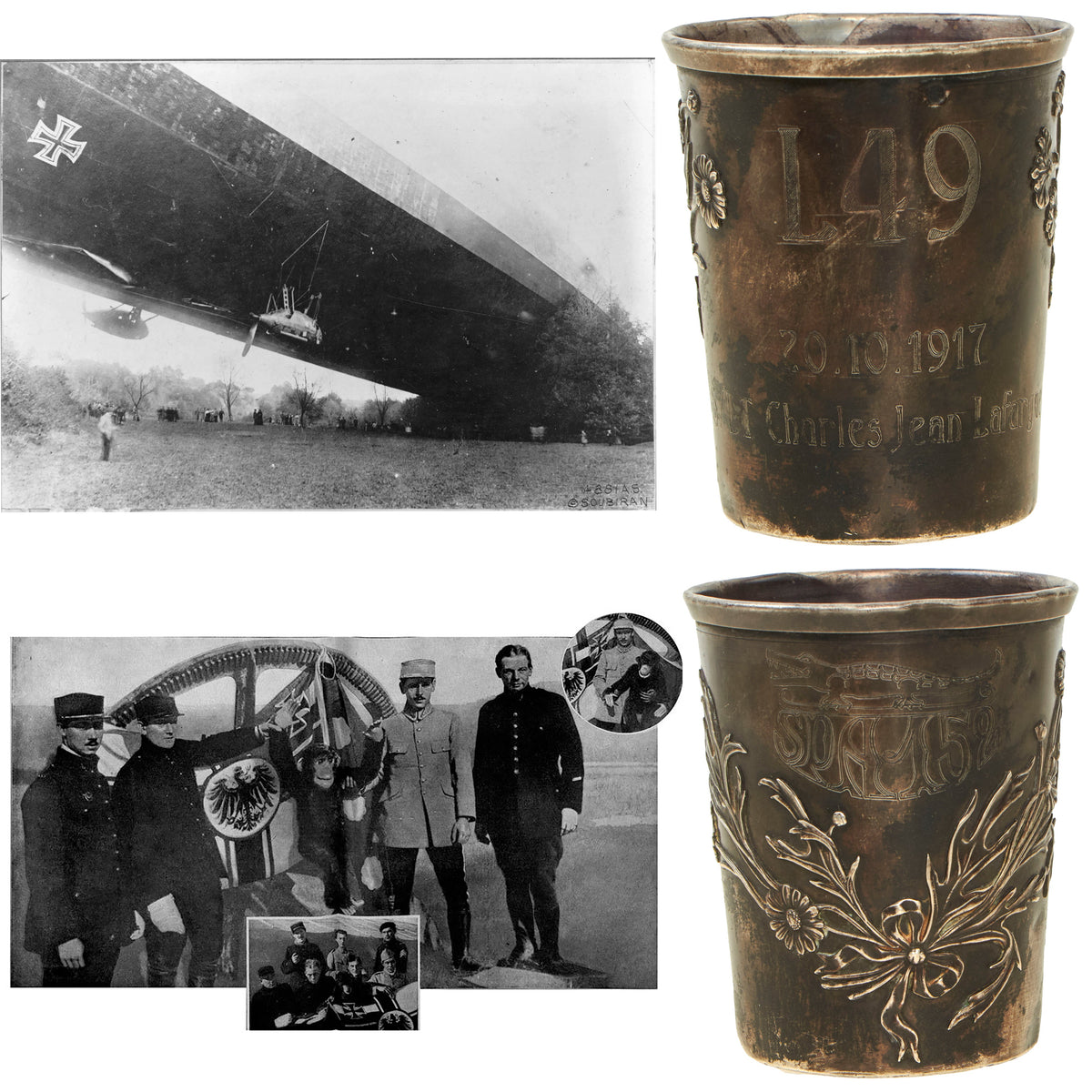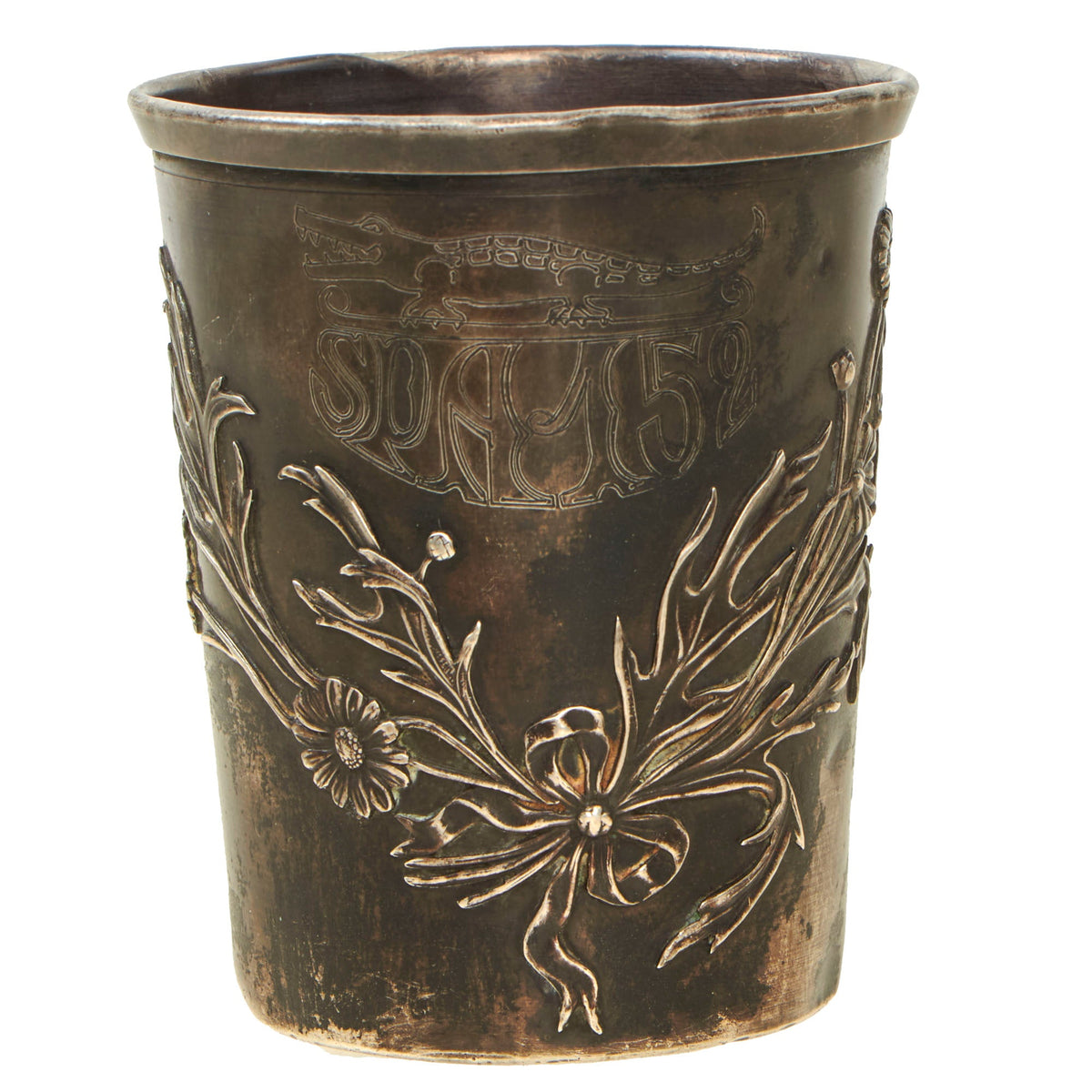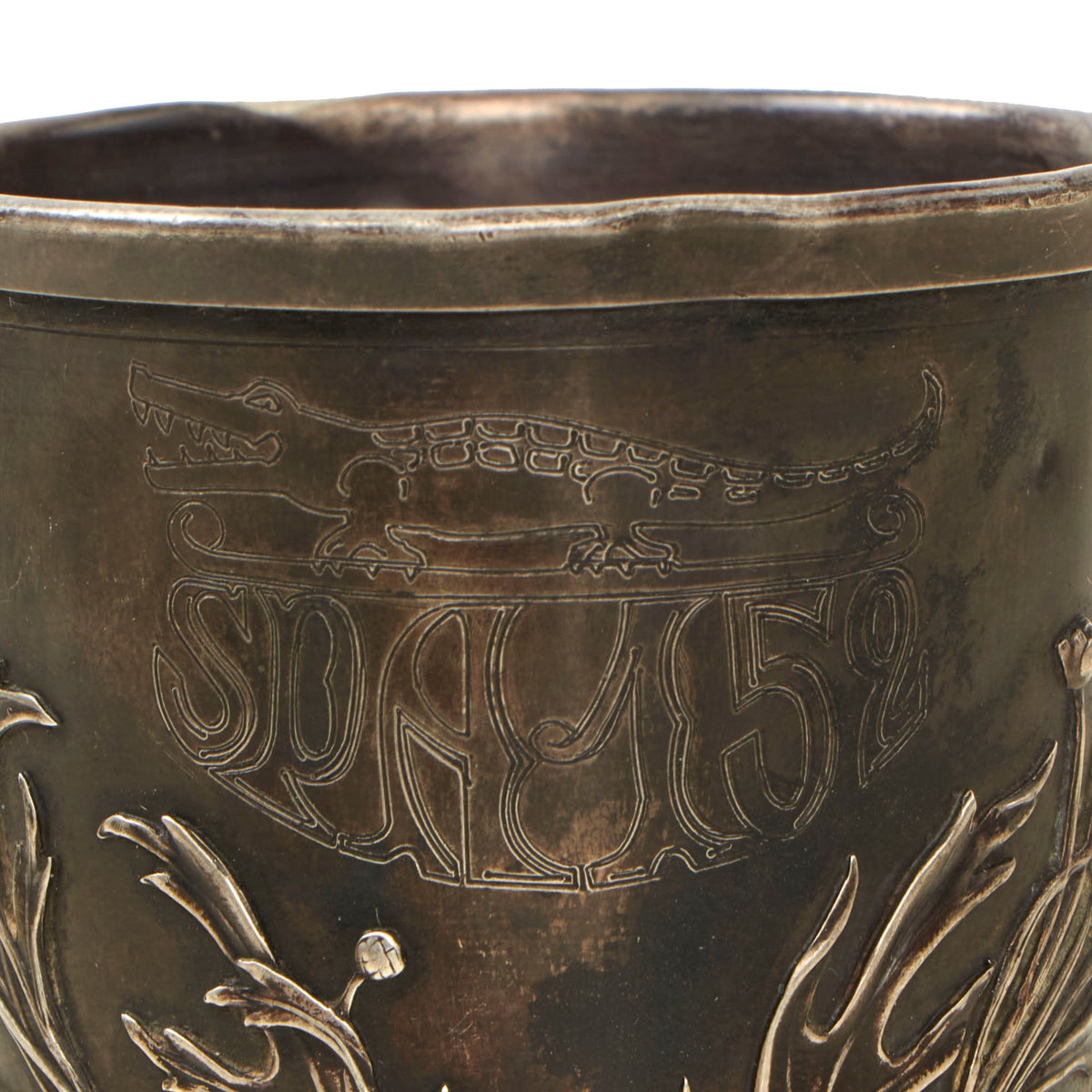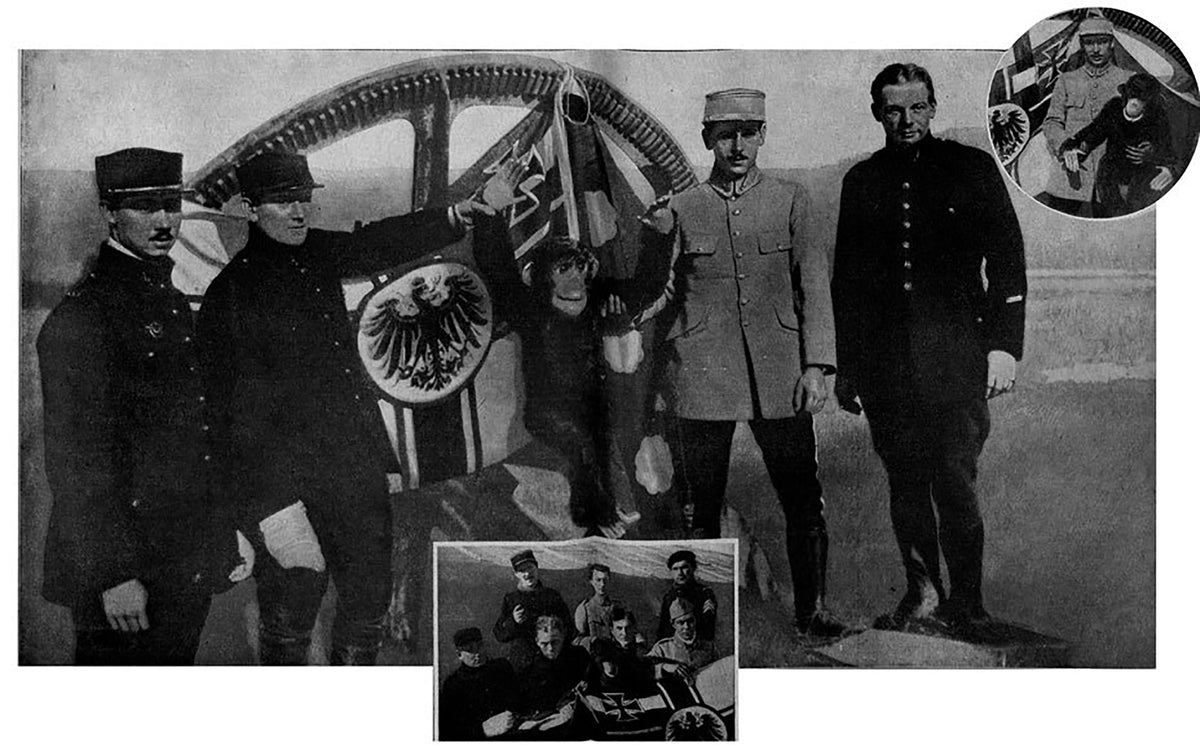Original French WWI Sgt (Sub/Lt.) Charles Jean LaFargue of Escadrille Spa.152 Silver Commemoration Cup For Actions Taken In Shooting Down German Airship L49 – The First German Airship Successfully Captured Original Items
$ 1.495,00 $ 373,75
Original Item: One-Of-A-Kind. This is an incredible piece of WWI history! This small silver cup was decorated to be used as a commemorative item for Sgt (Sub/Lt.) Charles Jean LaFargue of Escadrille Spa.152 “Crocodile” Squadron. What sets this cup apart from the many other encountered, is the fact that it was for LaFargue’s involvement in shooting down the German Airship L49. While shooting down a floating city may not seem that big of a feat, the L49 was the first German Zeppelin to have been successfully captured intact!
Escadrille Spa.152 was formed under the auspices of VII Armee at Lyon-Bron, France on July 9, 1917. Initially, it operated as a Nieuport fighter squadron and was designated as Escadrille N.152. In May 1918, the squadron transitioned to using SPAD fighters and was renamed Escadrille Spa.152. On June 4, 1918, it became part of a makeshift unit that evolved into Groupe de Combat 22 on July 1, 1918. Throughout the later stages of the war, Groupe de Combat 22 was involved in combat operations across three French field armies. By the end of the war on November 11, 1918, the squadron had been credited with the destruction of 15 enemy airplanes, 27 observation balloons, and a Zeppelin.
Markings Present On The Cup:
L49
20.10.1917
S/LT CHARLES JEAN LAFARGUE
SPA 152
We were able to source information on LaFargue, one of which was his citation for his involvement in the capture of L49:
“Fighter pilot of rare composure and courage worthy of praise. Has fought numerous battles aerial and during one of them shot down a German plane, on November 1, 1916, October 20, 1917, was part of a patrol of his squadrons launched in pursuit of Zeppelins and which, after two hours of combat, forced one of the airships to land, then set off alone to attack a second zeppelin, the pursuit of which he only abandoned when he ran out of fuel .”
The cup itself is in fantastic condition though the silver surface is now covered in a dark patina, which we left in place. It measures approximately 3 ⅛” tall with a mouth width of 2 ⅝” and a base width of 2”.
A wonderful piece of history that comes more than ready for further research and display.
The capture of the Zeppelin L 49 Extract from The Illustrated Air War
A Zeppelin is reported in the Epinal region at an altitude of around 3,000 meters. It appears to be heading south.
Immediately Lieutenant Lefèvre, head of N. 152, ran to warn all his pilots. It didn’t take much to open their eyes, still heavy with sleep.
Everywhere there is only one cry, repeated a hundred times in a rejoicing voice: “A Zeppelin, a Zeppelin!”
For a surprise, it’s a good surprise. This sad day ahead therefore takes on a festive air. All the pilots are soon assembled on the ground, while the mechanics rush out the available planes.
The mist has given way to a thick fog which hides the surroundings of the field. The ceiling is excessively low and faced with this state of the atmosphere, which is truly unfriendly, everyone begins to believe that they are the victims of a false alarm if not a mystification. The surest way to find out is to go and have a look, declared Lieutenant Lefèvre and ordered Second Lieutenant Lafargue to take to the air in order to judge whether the weather permits a cruise.
The officer takes off at 6:30 a.m., climbs and disappears almost immediately into the fog. Five minutes pass, as long as a century. The squadron waits, a little excitedly, for the result of the test flight. Finally, the plane comes out of the ceiling, dives down and lands in front of the hangars. Lafarque, overjoyed, screams at the top of his lungs: “The mist is very thick, but above 800 meters there is only intense blue and I saw two Zeppelins.”
Quickly, quickly on the way! It’s a general rush for devices. Two minutes later, the deafening roar of the engines running at full power fills the echo of the valleys. It’s gassy! Remove the wedges! And released, at full speed, five devices, like racehorses rushing towards the obstacle, roll twenty meters, leave the ground and disappear in the opacity of the fog. The hunting patrol is made up of second lieutenant Lafargue, quartermaster de la Marque, corporal quartermaster Vandendorpe, corporals Gresset and Denis. Lieutenant Lefèvre leaves a few moments later.
The layer of mist is quickly crossed by the Nieuports, who all meet up as soon as the blue of the sky is visible. Eyes eagerly search the clouds. Suddenly, over there, on the left, two long, slender, grayish spindles appear in the distance. Hurrah! They are the ones !
At full engine, it is the rush of the squadron on the Zeppelins whose shape becomes clearer, merciless rush of the dogs on the fierce boar, of the Davids on the formidable Goliath. Tragic moment which marks the beginning of a fierce, merciless and perhaps merciless struggle. deadly. The airships are at great height, heading towards the North-East. We must cut them off the lines, while climbing to a higher altitude. The pirates have undoubtedly seen their adversaries, because they are veering sharply towards the North while seeking to gain height. Unnecessary trouble.
The Nieuports climb faster than them and soon join the first pirate at 5,000 meters. Believing to have gone astray and in the absence of any reference point on the ground hidden by the mist, the behemoths turned around and deliberately headed towards the interior of France. The 152 planes did not give them time to regret this error. The closest ones are 200 meters from L. 49. The fight then begins, bitter and ardent. Lieutenant Lafargue and four of his pilots took turns charging at the pirate, discharging their machine guns at point-blank range in the direction of the pods.
The voices of murdered children in England and France demand revenge. Ta ca ta ta ta. The Nieuports will accomplish it. Ta ca ta ta ta. And the circle continues around the enormous carcass of canvas and aluminum, frantic circle at 200 kilometers per hour, punctuated without interruption by the sinister Ta ca ta ca ta. to which the Teutonic aeronauts are hardly accustomed. In the nacelles, twenty anguished men watch the planes move with perfect ease. They understand the tragedy of their situation. How will this crazy adventure end for them?
Each time the L. 49 tries to climb, the Nieuports climb above it to descend on it immediately, peppering it with bullets. The pirate’s commander must understand that his efforts will be in vain. He sets his machine on the descent. Its machine guns stop, only to resume as soon as the airship moves horizontally. The group gradually loses height. Suddenly at the front of the Zeppelin a white flag appears. Is this a feint?
Are the Boches convinced of their loss? The planes are constantly circling in all directions, some now in victory. Soon the ground appears, confused, A plateau presents itself, suitable for the landing of the mastodon. It drops, drops and ends up at the bottom of a small valley, on a bed of trees and bushes. In the final turn, squadron 152 ensures that the pirate cannot leave, then each on their own, haphazardly, the planes land nearby.
Meanwhile, the Zeppelin crew has gone down and Commander Gayer prepares to destroy his aircraft with an incendiary bullet. The Quartermaster of the Mark comes running. At the same time a hunter, Mr. Boiteux, joins him and without hesitation advances towards the group. “Don’t make a move or I’ll shoot!”
He takes aim at the Boches who no longer flinch. Their leader throws away his revolver. The other pilots of squadron 152 come at a gymnastic pace. Commander Gayer advances towards Lieutenant Lefèvre and says to him: “You are victorious. I surrender myself and my crew and we place ourselves under your protection.”
The Boche officer was greatly surprised when he learned that he was a few kilometers from Bourbonne-les-Bains.
“I thought I was in Holland,” he declared, “and I was convinced that you were Belgian aviators. That’s why I was very surprised to see you chasing me here and landing next to me.”
He said he was part of a squadron of ten Zeppelins whose mission was to bomb England during the night of October 19 to 20. Fiercely, the Boche regrets not having been brought down on fire, as well as not having been able to destroy his balloon. His disappointment increases further when Lieutenant Lefèvre tells him that his Zeppelin has passed through the Epinal region, less than twenty kilometers from the lines!
Sad and sheepish, the crew of the L. 49, made up of a commander, a lieutenant and 17 men and non-commissioned officers, leaves for captivity, supervised by gendarmes who have not yet recovered from their surprise. During the ups and downs of this almost unprecedented fight, the second Zeppelin was attacked by two planes from the 152 as well as by different squadrons from the Eastern region. The pirate defended himself fiercely using his three machine guns, then finally he was able to disappear into the mist. Was it he who ended up so pitifully at Misson, in the Basses-Alpes? It’s more than likely. The result obtained should delight us.
In addition to the three other Zeppelins taken down or forced to land at various points, the capture of the L. 49 constitutes a unique feat to this day and which does honor to the now famous squadron commanded by Lieutenant Lefèvre. The pilots who defeated the German pirate can be proud. It’s a bit of revenge that they bring to the unfortunate victims of Nancy, Dunkirk, Bar-le-Duc and many other towns, victims who are mourned a lot but who are not avenged enough.
Official report from Lieutenant Lefèvre
Head of Squadron N 152
On October 20, 1917, the squadron cyclist brought me at 6 a.m. 15 the following telephone message: “6:10 a.m. An enemy airship is coming to Epinal, coming from the North, 2,500 to 3,000 meters.”
I immediately alerted all the pilots in the squadron and transmitted the order through the cyclist to immediately take out all available devices. Arrived at the field at 6 a.m. 25, still having doubts about the presence of these airships, I telephoned Epinal which, twice, quickly informed me of the presence of two airships traveling together.
The weather was absolutely bad: a thick layer of very low mist completely hid the sky, and I hesitated to send my Pilots out. However, I ordered Second Lieutenant Lafargue to cross the layer of mist and try to see the Zeppelins and land immediately.
Second Lieutenant Lafargue left at 6 a.m. 30, was back at 6am. 35, telling me that the mist was very thick and rose up to 800 meters; but that above there was only intense blue and that he had seen the two Zeppelins in the distance.
I ordered the patrol (second lieutenant Lafargue, patrol leader, quartermaster of La Marque, corporal-fourrier Vandendorpe, corporal Denis, corporal Gresset) to set off. Second Lieutenant Lafargue immediately takes off and the 3 others follow him. Corporal Vandendorpe alone cannot leave due to a breakdown.
During this time, my device being unavailable, I took out the device of the quartermaster D. who had left on leave the day before; I quickly try it and take off following Corporal Denis.
The aircraft were immediately lost in the layer of mist, but found themselves 900 meters out of the mist, with Second Lieutenant Lafargue leading the formation. Immediately, I saw the two Zeppelins at great height heading towards the North-East. I place them roughly between Epinal and Lunéville; the thick mist completely hiding the ground from me prevents me from knowing exactly where I am.
The patrol takes its height by heading between the Zeppelins and the lines to cut them off. Arriving at 4,000 meters, the Zeppelin on the right must have seen us, because it changes its route to the North-East, to go straight north, followed by the second Zeppelin which was to its left.
At this time, there are only four of us left, one of the Nieuports, Corporal Denis has left us. Arriving at 5,300 meters, the patrol is higher than the Zeppelin and is heading straight for it. Believing in the attack, the Zeppelin made a quarter turn and headed southwest; the second, higher up, immediately does the same maneuver; the first result is acquired, they turn around and return directly to France. Second Lieutenant Lafargue, patrol leader, attacked L. 49 at this time and indicated that the fight was beginning. The other devices then attack simultaneously. The Zeppelin, moreover, immediately suffered the blow; it seems to me that it is going down. At this point, I count my devices again. There are five of us, Corporal-fourrier Vandendorpe, who was rescued, was able to join us.
As long as the Zeppelin dives, we follow it without firing, but as soon as it tries to right itself, two aircraft immediately dive simultaneously and as soon as the L. 49 hears the machine guns, it starts to dive. After a very steep dive, he tried to escape us by an almost vertical climb. At this moment. we dived on it and the Zeppelin did not insist. To make it sting, without igniting it, we continued to fire a few rounds next to it. Arriving at around 1,000 meters, the airship displayed a white flag at the front, signaling that it was surrendering. Our planes continued to circle around.
Around 300 meters, I see land; we pass 200 meters between two woods and the airship lands gently. We circle around until the crew is out and the balloon appears in a situation from which it cannot leave; It’s 8 a.m. 45. I land immediately 800 meters from the balloon, followed by three of my pilots; I rush across the fields, gathering behind me a few peasants and hunters, and I arrive alongside the Zeppelin.
The crew met 100 meters from L. 49; the captain walks towards me and says: “You are the winner, here is my crew, I put myself under your protection and I consider myself a prisoner of war.”
I immediately gathered a few civilians with rifles, I left the L 49 under the guard of two pilots and these volunteers and, with the quartermaster of La Marque at the head of the 19 prisoners, I headed towards Bourbonne-lesBains, from afraid that the overexcited population would hit the prisoners. I hand over the prisoners to the Gendarmerie, with orders to isolate them from each other. Left at 6 a.m. 35, the patrol landed at 6 a.m. 45.
Corporal Denis had chased the second Zeppelin. Arriving at an altitude of 5,600 meters he engaged in combat at 800 meters. He was then caught under violent fire from machine guns firing explosive bullets. Then he suddenly ran out of fuel and had to land at Rouvres-la Chétive (10 kilometers from Neufchâteau) at 9 a.m. 20.
The lucky charm of the L 49:
After the end of L. 49, we owe to the winners of L. 49 themselves these documents which are of primordial interest: they are the only ones which were not published in all the newspapers. We thus see that the Boches are also fetishists. Unfortunately for them, fortunately for us, their old God takes great pleasure, sometimes! to turn what they consider to be a good luck charm into a lucky charm. On board the L. 49, the pilots who managed to triumph over the juggernaut discovered a monkey.
Fast Shipping with Professional Packaging
Thanks to our longstanding association with UPS FedEx DHL, and other major international carriers, we are able to provide a range of shipping options. Our warehouse staff is expertly trained and will wrap your products according to our exact and precise specifications. Prior to shipping, your goods will be thoroughly examined and securely secured. We ship to thousands clients each day across multiple countries. This shows how we're dedicated to be the largest retailer on the internet. Warehouses and distribution centres can be located throughout Europe as well as the USA.
Note: Orders with more than one item will be assigned a processing date depending on the item.
Before shipping before shipping, we'll conduct a thorough inspection of the items you have ordered. Today, the majority of orders will be delivered within 48 hours. The delivery time will be between 3-7 days.
Returns
The stock is dynamic and we cannot completely manage it because multiple stakeholders are involved, including our factory and warehouse. So the actual stock may alter at any time. It's possible that you may not receive your order once the order has been made.
Our policy is valid for a period of 30 days. If you don't receive the product within 30 days, we are not able to issue a refund or an exchange.
You can only return an item if it is unused and in the same state as the day you received it. You must have the item in its original packaging.
Related products
Uncategorized
Uncategorized
Uncategorized
Uncategorized
Uncategorized
Armoured Fighting Vehicles of the World: AFVs of World War One (Hardcover Book) New Made Items
Uncategorized
Uncategorized
Uncategorized
Uncategorized
Uncategorized
Band of Brothers ORIGINAL GERMAN WWII Le. F.H. 18 10.5cm ARTILLERY PIECE Original Items
Uncategorized
Uncategorized
Uncategorized
Uncategorized
Uncategorized
Uncategorized












































































